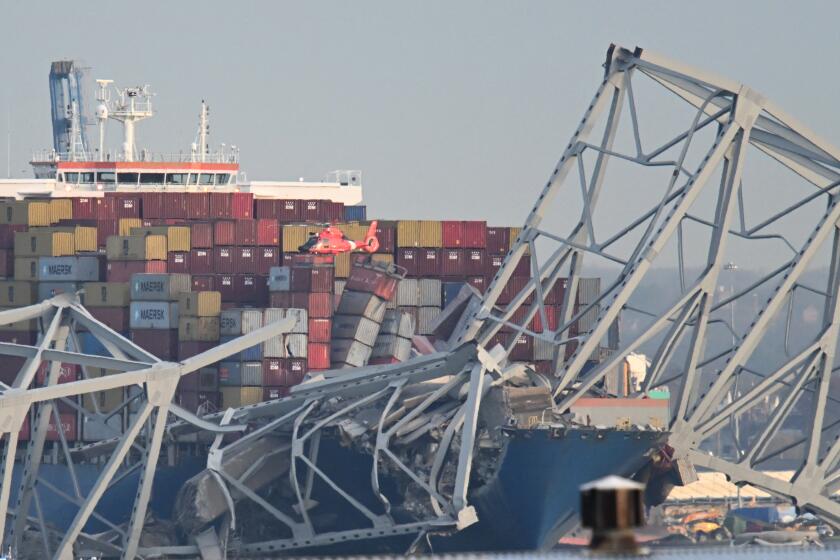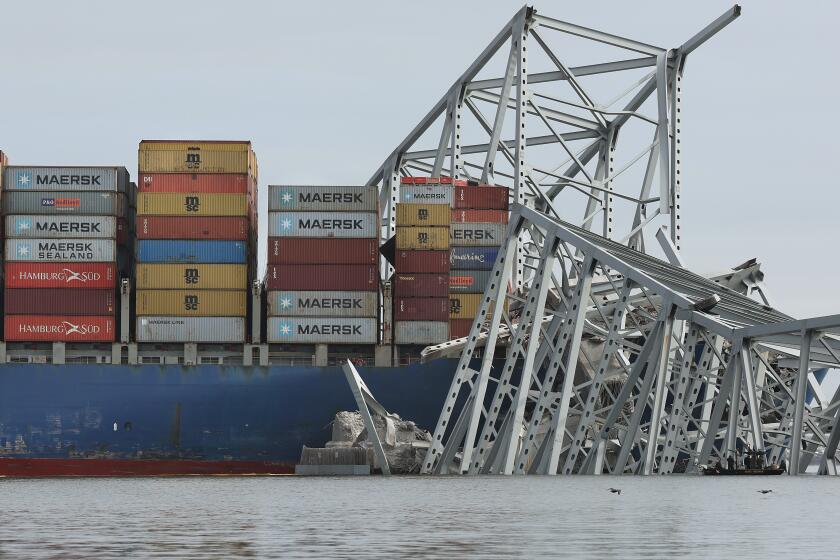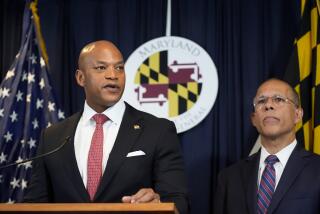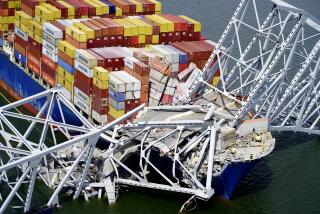2 bodies pulled from underwater wreckage of collapsed Baltimore bridge
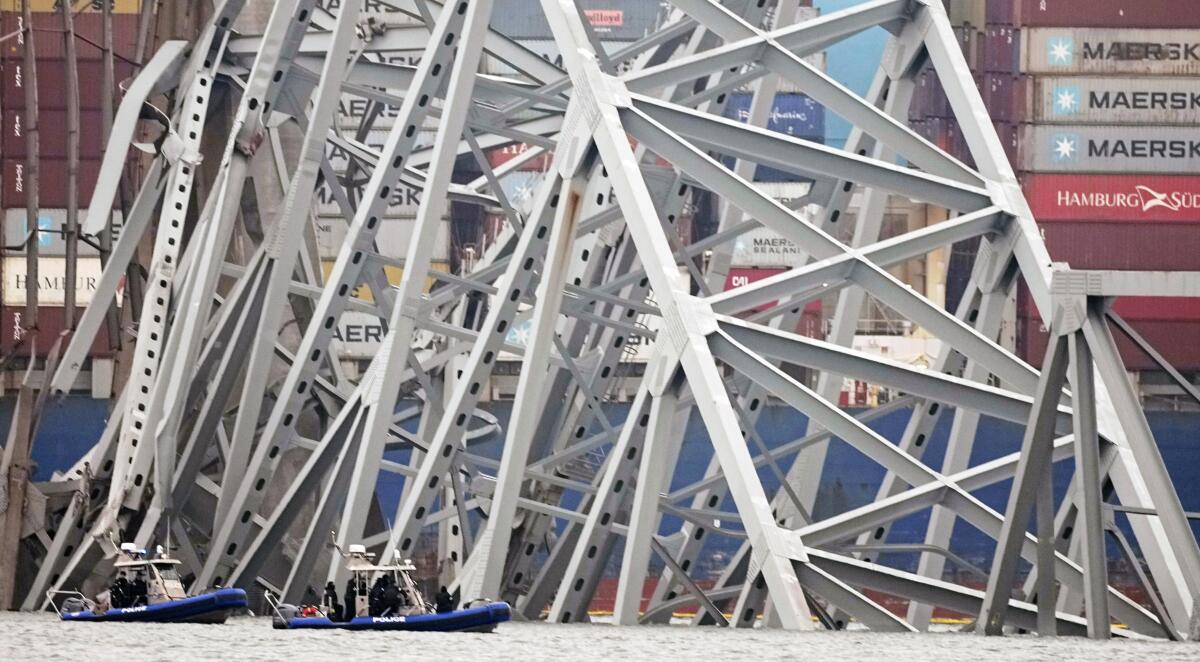
- Share via
The bodies of two men, found inside a submerged red pickup, were recovered from the wreckage of the Baltimore bridge collapse on Wednesday morning, officials said. And now the recovery mission has become a salvage operation.
The saga surrounding the Francis Scott Key Bridge began early Tuesday with a mayday alert from crew members of a 985-foot-long container ship en route to Sri Lanka.
“Numerous audible alarms” had begun blaring aboard the vessel at about 1:25 a.m. Tuesday, according to Marcel Muise, an investigator with the National Transportation Safety Board, who spoke at a news conference Wednesday evening.
At 1:27 a.m., the pilot ordered the cargo ship to drop the port anchor and issued “additional steering commands.” The pilot then issued a radio call reporting the ship “had lost all power and was approaching the bridge.”
A dispatch call to officers on the bridge followed shortly after, at 1:28 a.m.
“I need one of you guys on the south side, one of you guys on the north side — hold all traffic on the Key Bridge,” an emergency dispatcher told two police officers from the Maryland Transportation Authority, according to dispatch calls provided by Broadcastify.
As the ship approached, going 8 knots — about 9 mph — the two officers quickly stationed themselves on either side of Baltimore’s storied bridge to stop all vehicles from driving over the 1.6-mile span.
A construction crew was at work on the bridge, repairing masonry and potholes. The dispatcher asked the officers to notify the foreman and see if the workers could be evacuated.
But it was too late. The ship plowed into one of the bridge’s support pillars, sending portions of the span into the 50-foot-deep Patapsco River below.
At 1:29 a.m., the ship’s data recorder captured “sounds consistent with the collision of the bridge,” Muise said, while at the same time, Maryland Transportation Authority cameras captured bridge lights going out.
A major bridge in Baltimore collapsed after a container ship rammed into it, sending a construction crew and five vehicles into the river below, officials said.
“The whole bridge just fell down!” one of the officers shouted. “Start, whoever, everybody. The whole bridge just collapsed!”
Eight construction workers plummeted into the frigid waters below. Two were rescued; one declined treatment and the other was hospitalized. Authorities had to halt the initial search for the rest of the crew about 18 hours after the bridge’s collapse, saying debris and changing currents were hampering rescue efforts.
The remains of two people were recovered Wednesday morning, Col. Roland L. Butler Jr. of the Maryland State Police said. The bodies were found just before 10 a.m. in a truck that was submerged in 25 feet of water near the middle of the bridge.
They were identified as 35-year-old Alejandro Hernandez Fuentes of Baltimore and 26-year-old Dorlian Castillo Cabrera of Dundalk, Md., Butler said. Fuentes was from Mexico and Castillo was from Guatemala.
Divers are no longer able to safely search around the wreckage due to the amount of debris, according to Butler, who added that search efforts around the bridge itself had been exhausted.
Butler said efforts would be focused on salvage now.
“Based on sonar scans, we firmly believe that the vehicles are encased in the superstructure and concrete that we tragically saw come down,” he said.
NTSB Chair Jennifer Homendy said Wednesday that the Key Bridge was “fracture-critical.” With this type of construction, she said, when one important section is fractured, the entire structure may be vulnerable to collapse.
The “preferred method” of construction today includes “redundancy” built into bridges, Homendy noted, which allows the structure to essentially transmit the load if one portion is compromised.
The bridge was in “satisfactory condition,” with the last fracture-critical inspection in May 2023, but investigators have requested additional safety documentation. Homendy said there are 17,468 fracture-critical bridges in the country today out of a total 615,000.
The bridge investigation could take as long as two years to complete, Homendy said, although the team will issue any urgent safety recommendations in the meantime.
Baltimore Mayor Brandon Scott called the bridge’s collapse “something out of an action movie.” The region has since been grappling not only with the loss of a vital transportation link but also the closure of the Port of Baltimore, which experts say could severely hobble the economy.
But Scott also commended the officers who responded to the mayday alert and tried to keep everyone off the bridge before the crash.
“By being able to stop cars from coming over the bridge, these people are heroes,” Scott said at a Tuesday news conference. “They saved lives.”
Experts say the Baltimore collapse does not expose significant vulnerabilities in the major bridges near ports across California. The ports of Los Angeles and Long Beach handle about 40% of U.S. container imports from Asia.
About 30,000 vehicles cross the bridge daily, but the collapse occurred well before the busy morning commute. At least five vehicles plunged into the water — a cement truck, three passenger vehicles and one vehicle that was unidentified — which rescue crews used sonar to detect, Baltimore Fire Chief James Wallace told CNN.
The six men presumed dead are from Latin American countries, according to multiple reports.
Miguel Luna, from El Salvador, left for work at 6:30 p.m. Monday and didn’t come back, according to immigrant services nonprofit We Are Casa. Luna was married and the father of three children. He had lived in Maryland for 19 years.
“They only tell us that we have to wait, that for now, they can’t give us information,” Luna’s wife, María del Carmen Castellón, told Telemundo 44. “Our heart is broken because we don’t know if they’ve rescued them yet. We’re just waiting to hear any news.”
Maynor Yassir Suazo Sandoval, 38, was from Honduras and had lived in the U.S. for 18 years, his brother, Martin Suazo, told CNN. Sandoval was married and the father of an 18-year-old son and 5-year-old daughter.
One of Sandoval’s relatives, Marina Maldonado Villeda, described Sandoval in a Facebook post as “a guy with warmth and quality of people, entrepreneur with a vision and mission to serve our community.”
“We wish with our hearts that he is alive, Our prayers to see you again and continue to enjoy your joy and enthusiasm. We hug you with the Suazo Sandoval family,” Villeda wrote.
Guatemala’s Foreign Ministry confirmed that two of the presumed victims were Guatemalan nationals, although the agency didn’t identify them by name, saying only they were 26 and 35 years old and originally from San Luis, Petén, and Camotán, Chiquimula.
Mexican President Andrés Manuel López Obrador also confirmed to reporters that three Mexican nationals were victims of the bridge collapse. One was rescued.
President Biden pledged Tuesday to use federal money to help rebuild the bridge and reopen the port, but Transportation Secretary Pete Buttigieg told reporters in a Wednesday news briefing that it would not be “quick or easy or cheap,” noting that the span originally took five years to build.
Buttigieg also said that if it were not for the distress call, the quick actions of the first responders and the time when the collapse occurred, the death toll could’ve been much higher.
“If not for several factors ... loss of life might have been in the dozens,” he added.
More to Read
Sign up for Essential California
The most important California stories and recommendations in your inbox every morning.
You may occasionally receive promotional content from the Los Angeles Times.
